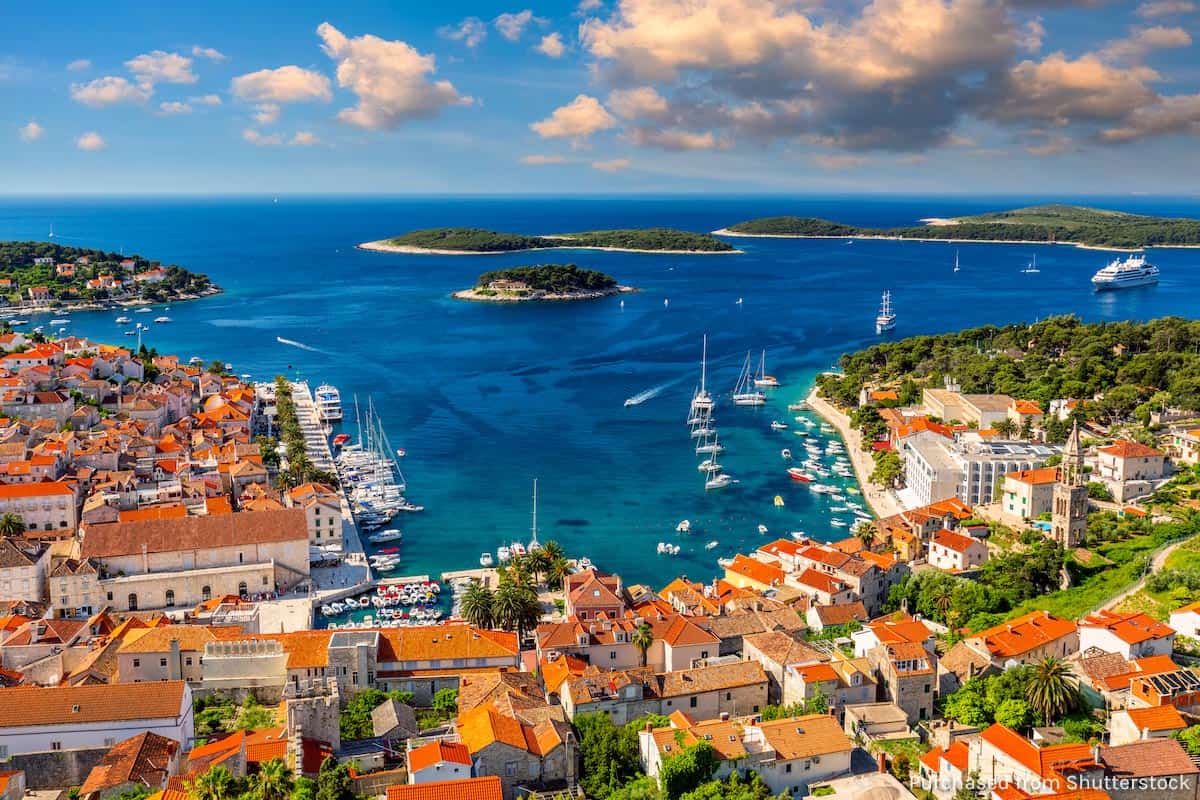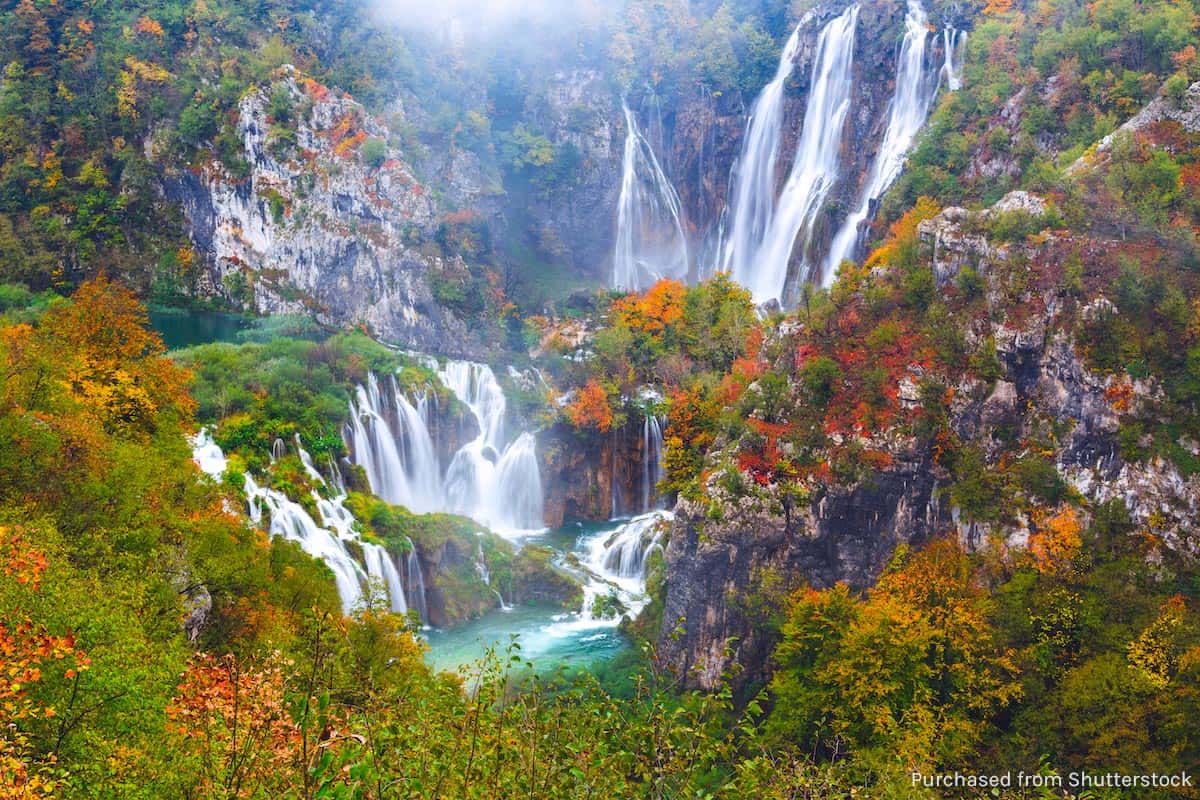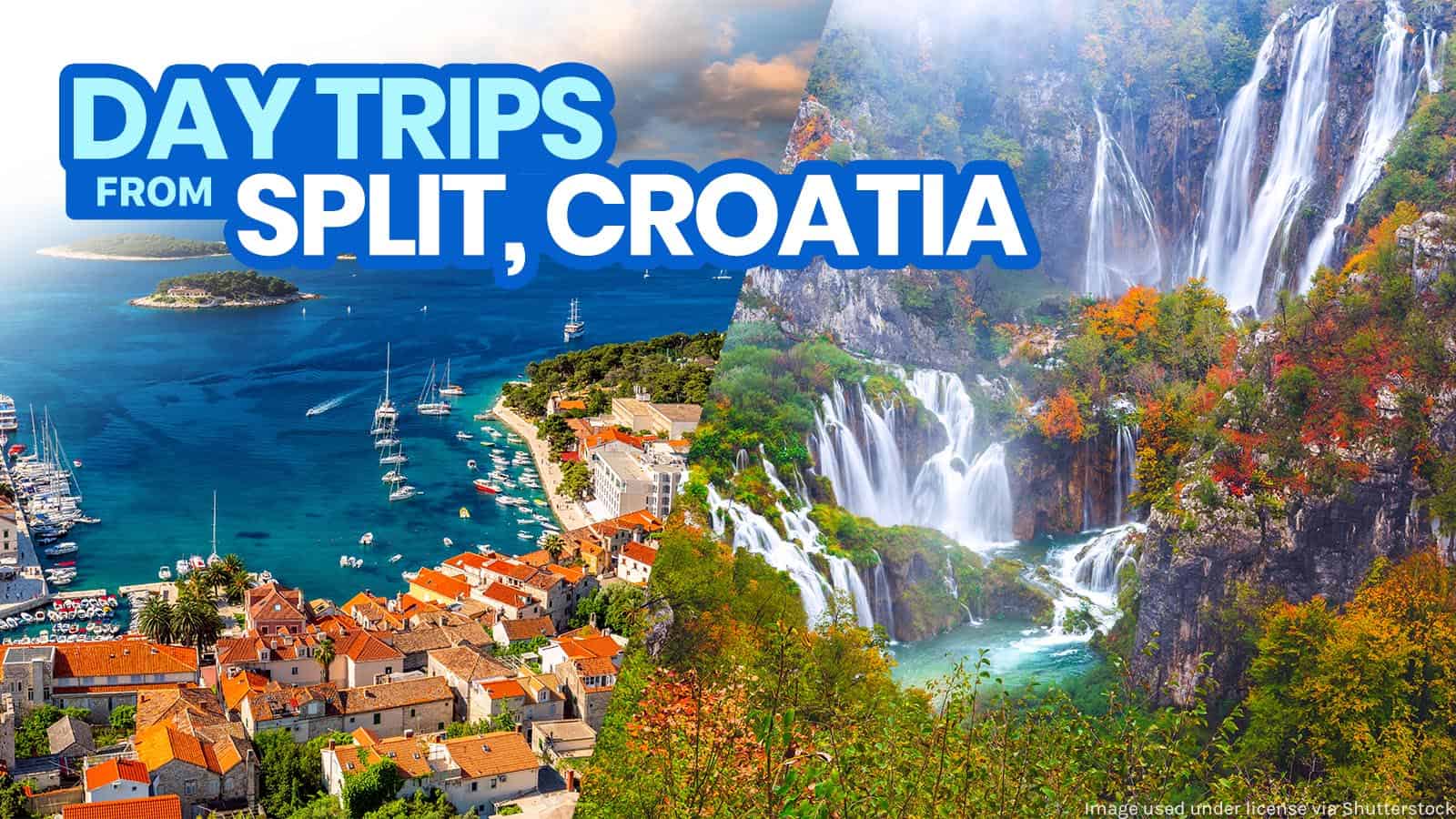Split city center is peppered with numerous attractions that can easily fill a few days’ itinerary. But the city is also a great jump-off point to other exciting destinations in Croatia.
For starters, from Split, two national parks are within easy reach — one is punctuated with waterfalls and the other with exquisite lakes. It’s also the gateway to some of the idyllic islands that speck the Adriatic Sea.
Here are some of the attractions that you can visit on a day trip from Split. The first five destinations on this list can be explored on an island-hopping tour. Klook is offering this tour inclusive of the following:
- Speedboat transfer between the islands
- An English speaking captain and the crew
- Windproof jackets
- Snorkeling equipment
- Onboard soft drink
- Insurance
1. Hvar Island

Hvar is a long slice of paradise lounging in the Adriatic Sea along with other neighboring islands. It is famed for its beach parties (day and night) and bars. High-end restaurants, bars, and hotels fill the resort town.
The harbor in Hvar is festooned with yachts. This is also the main jump-off point to nearby Pakleni Islands. The Hvar Cathedral, the 13th-century wall, and Fortica are just some of the historical landmarks. The southern coast is bedecked with secluded beaches and coves. Away from the coastal areas, the interior features fertile land, olive groves, vineyards, and abandoned medieval hamlets. The island also boasts charming lavender fields, attracting tourists during its bloom season.
Most of the tourism activities are concentrated on the western portion where the town of Hvar and harbor are located, particularly on the southwestern coast. Most of the facilities and amenities are found here. The main ferry terminal, Stari Grad, is also on this side of the island but on the northwest coast.
Nearest Ferry Port: Stari Grad Port
Getting There: Take the passenger ferry from Split Port near the old city to Stari Grad Port.
Fare: KN 35 – KN 55. The fares vary depending on the season. Rates during the summer season spike significantly. The travel time is about two hours.
2. Biševo Island
The eastern side of the Adriatic Sea is specked with islets. This archipelago is under the jurisdiction of the Dalmatia region. Biševo is a small island that lies southwest of the much bigger island, Vis.
The island’s total land area is under six square kilometers, and the population is not more than 30 permanent residents. The most prominent historical landmark is the Church of Saint Sylvester near the ruins of the ancient Benedictine monastery at the heart of the island.
The island’s limestone coast is also carved with caves. The Blue Cave is the most visited by tourists. The water inside the cave reflects a blue and silver shimmer. The best time to visit is from midmorning to early afternoon during the summer months. Another attraction is the Monk Seal Cave.
Nearest Ferry Port: Porat Port
Getting There: Taking public ferries is quite a lengthy route. You need to go to Vis Island first. From there, ride a bus to Komiza Port where you can board a ferry to Biševo. The best option is to join an organized tour or an island-hopping tour. This way, you can also visit other islands instead of just spending most of your time exploring just one.
Blue Cave Entrance Fee: Off-peak Season KN 75 (Adults), KN 35 (6-12 y/o); Peak Season KN 100 (Adults), KN 50 (6-12 y/o); FREE (Children below 6 y/o)
3. Vis Island
Vis is a small inhabited island in the Adriatic Sea off the coast of Dalmatia. It is located southwest of Hvas and northeast of Biševo. When the island was finally abandoned by the Yugoslav army in 1989, the island’s rugged beauty shines, attracting tourists.
Today, agriculture, fishing, and tourism are the main sources of income of Vis. The major settlements are located far apart — the town of Vis on the northeastern side and the town of Komiža on the western side. The island is the filming location of the Hollywood movie ‘Mamma Mia! Here We Go Again’.
Vis town is dotted with medieval ruins and structures like churches, ancient Roman baths, and villas. Saint Jerome Church on the Prirovo peninsula is constructed on the site of an ancient Roman theater. The main attraction is the Archaeological Museum, hosted in the Levaman Fortress. The museum showcases several artifacts and Greek sculptures; the most significant is the bronze head of Artemis, dating back to the 4th century BC. Komiža has the Komiza Castle, St. Nicholas Church, and the beaches. Komiza Port is the jumping-off point to Biševo Island and to nearby diving spots.
Nearest Ferry Port: Vis Port
Getting There: Take the passenger ferry from Split Port near the old city to Vis Port.
Fare: KN 45 – KN 55. The fares vary depending on the season. Rates during the summer season spike significantly. The travel time is about 2.5 hours.
4. Budikovac Island
Budikovac is a small island off the southeast coast of Vis island. The key attraction is the central beach on the western side of the island.
Bounded by two islets — Small Budikovac and Sanak — on the west and Budikovac island on the east, the central beach is also popularly called the Blue Lagoon. Its clear blue water entices island-hoppers to swim and snorkel. There’s a small restaurant owned by the lone resident of the island. He also has a vegetable field and animal farm beside his house.
Nearest Ferry Port: Vis Port
Getting There: There are no passenger ferries plying this route from Split. You need to go to Vis Island first. From there, book a tour or charter a private boat to Budikovac. The most practical option is to join an island-hopping tour from Split. Make sure that Budikovac is included in the itinerary if you really want to visit this island.
5. Pakleni Islands
Also called Paklinski Islands, these are a group of islands that look like a broken chain southeast of Hvar Island. Looking at the map, it looks like the cluster is part of Hvar because of the proximity.
These islands, big or small, boast coves, numerous beaches, and sea caves. The closest to Hvar is Jerolim Island. The largest among the islands is Sveti Klement, cradling three villages.
Getting There: The jumping-off point is Hvar Port. The passenger ferry will drop you to any of these islands: Jerolim, Stipanska, or Palmizana. Another option is to book and join an island-hopping tour that includes Pakleni in the itinerary.
6. Krka National Park
Declared a national park in 1985, Krka National Park is an important ecological, cultural, and tourism site. It covers 109 square kilometers of protected land that is home to several endemic species of flora and fauna. Straddling the Krka River in the Central Dalmatia region, the park’s crowning glory is the series of seven waterfalls.
Located in the north is Roški Slap, a waterfall surrounded by walking paths and viewing spots. Situated in the south is the most famous waterfall within the park, Skradinski Buk. It features a vast natural pool and smaller cascades aside from the main waterfall. There are also walking trails and viewing spots.
Another tourist attraction is the Visovac Island, which houses a 15th-century Franciscan monastery. The centuries-old Krka Monastery is also a noteworthy destination. It is located north of Roški Slap.
Entrance Fee: KN 30 (January – March, November – December); KN 100 (April – May & October); KN 200 (June – September). These rates are for adults. From ages seven to eighteen, the rates are KN 20/KN 80/KN 120. Children seven years old and below are free of charge. The fee includes access to all land sites in the Krka National Park.
Opening Hours: Skradinski Buk follows a different schedule. It is open all year round, while other sites are CLOSED during winter months (January – March, November – December). Skradinski Buk starts operation at 9AM during the winter season, 8AM outside the winter season. Closing time varies from 4PM to 8PM. Other sites open at 10AM and close at 5-6:30PM from April to October.
Getting There: There are five entrances to the park — Skradin, Lozovac, Roski Slap/Laskovica, Burnum/Puljane, and Kistanje/Krka Monastery. There are direct bus routes from Split to Skradin. The travel time is 1.5-2 hours. The fare is KN 65 – KN 75.
Below is a day tour to Krka National Park from Split. This is inclusive of roundtrip transfers, onboard WiFi, an English-speaking guide, a bottle of water, and insurance. If you want a hassle-free transfer, you can book this tour.
7. Plitvice Lakes National Park

Located in the mountainous region of Central Croatia, Plitvice Lakes National Park will overwhelm you with stunning views and natural wonders. Being one of the largest and oldest national parks in Croatia, it offers numerous hiking trails for both beginners and hardcore hikers.
The vast, lush alpine forests are scribbled with caves, lakes, rivers, and waterfalls. But the highlight is the lake terraces formed by sixteen lakes, flowing from top to bottom, forming magnificent waterfalls. The highest among these falls is the 78-meter-high Veliki Slap.
Visitors can traverse and explore the lakes and the falls through the walkways snaking around and through the waters. Each lake and waterfall has its own stories and legends. Founded in 1949, it is further protected when it is recognized by UNESCO as a World Heritage Site in 1979.
Entrance Fee: KN 80 (January – March, November – December); KN 180 (April – May & October); KN 300 (June – September). These rates are for adults. Children from seven to seventeen years old get less than half of the rates for adults. Children under seven years old are free of charge.
Opening Hours: 8AM – 4PM (October – March), 8AM – 7PM (March – May), 7AM – 8PM (June – 20 August), 7AM – 7PM (21 August – September). Note that last entry, ticket purchase, and exchanging vouchers are done TWO HOURS BEFORE closing time.
Getting There: From Split, go to the main bus terminal near the port and board a bus bound for Plitvice Lakes. There are direct routes offered from Split. The travel time is 3-4 hours. The fare is KN 135 – KN 175.
If you want to travel conveniently and learn more insights and stories about the lakes, you can book a guided tour. The day tour below covers roundtrip transportation between Plitvice and Split, onboard WiFi, an English-speaking guide, boat ride, a bottle of water, and insurance.
8. Sibenik
Sibenik, the third-largest city in the Central Dalmatia region, is located northeast of Split and south of Krka National Park. This coastal city is also the main gateway to the Kornati archipelago, which is composed of 150 islands and is located west of Sibenik.
The oldest native Croatian city along the Adriatic Sea, the city is home to many ancient cultural and historical landmarks, including two UNESCO World Heritage Sites — the Cathedral of St. James at the city center and St. Nicholas Fortress on an island. There are three more historic fortresses in Sibenik aside from St. Nicholas: St. Michael’s Fortress, St.John Fortress, and Barone Fortress. The city also has beaches, resorts, restaurants, and bars.
Nearest Bus Stop: Sibenik Bus Terminal
Getting There: Buses are the fastest and most convenient mode of transportation to Sibenik from Split. If you are taking the train, you need to change trains at Perkovic and may take 2.5 hours. The fare is cheaper when you take the bus. There are direct bus routes from Split to Sibenik. The travel time is about 1.5 hours.
Fare: The bus fare is KN 45 – KN 55.
If you want to visit both Sibenik and Krka National Park, there are companies that offer this tour. The package below from Split includes roundtrip transportation, Krka National Park entrance fee, a professional guide, insurance, and a bottle of water.
9. Cetina River Rafting
Flowing from the alluring springs in the northwestern slopes of Mount Dinara, Cetina River snakes through cities and towns in the Dalmatia region before it enters the Adriatic Sea. For the adventurous, a thrilling way to explore and go sightseeing is through a rafting experience on the Cetina River.
Get your adrenaline pumping as you course through the river, basking in the raw beauty of nature enveloping you and taking your breath away. You can also stop for a while and take a short swim.
Cetina River Rafting tours are offered by operators from Split. You can also find packages online and book it ahead of time.
10. Cetina River Canyoning
This is another level of extreme. Canyoning is like a mixture of hiking, cliff-diving, and rappelling. If you are not afraid of heights and into a thrilling outdoor experience, canyoning is the best way to immerse yourself in Croatian nature. Enjoy the view as you scale the canyon and cliffs. Scream your heart out as you splash and slide your way through clear waters.
This canyoning tour package from Split to Cetina includes roundtrip transfers, safety briefing, a certified professional instructor, insurance, and full canyoning gear — wetsuits, life jackets, and helmets.
11. Klis Fortress
Located northeast of Split, Klis Fortress is perched high on a pass that separates Mosor and Kozjak mountains, making it a strategic structure for defensive purposes. Consequently, its history reveals that it has served its purpose well for over 2,000 years ago, starting from the Dalmatae, an ancient Illyrian tribe to the reigns of the Roman Empire, the Croatian monarchs, and up to the Ottomans.
It provides a bird’s eye view of the other nearby ancient villages, the vineyards and olive groves, the city of Split, and the Adriatic Sea. Visit at sunset to witness the lights gradually illuminate Split. The mountain fortress is also one of the filming sites of the TV series Game of Thrones. It was chosen as a setting for Meereen.
Entrance Fee: KN 60 (Adults), KN 30 (Children)
Opening Hours: 9:00 AM – 4:00 PM
Getting There: There are direct bus routes from Split to Klis Fortress. Take Bus 22 from Split and get off at the last stop. The travel time is about 20 minutes. The fare is KN 15 – KN 25.
12. Trogir
Situated about 15 kilometers west of Split, Trogir is a harbor town on the eastern coast of the Adriatic Sea. Its history spans over 2000 years when the ancient Greeks first settled and develop the area. Its culture is the result of the integration of different colonial cultures — Greeks, Romans, and Venetians.
Its old city center, built on a small island sandwiched between the mainland and Čiovo Island, was declared a UNESCO World Heritage Site in 1997. Some of the noteworthy attractions are the 13th-century Cathedral of St. Lawrence, the medieval city wall ruins, Fortress Kamerlengo, the Duke’s Palace, and the Trogir Promenade. The old city is peppered with several other palaces, churches, fortresses, and towers.
Nearest Bus Stop: Trogir Bus Terminal
Getting There: Buses from Split departs from either the main bus station or the Sukoisanska Bus Terminal, about 1.5 kilometers from the city center. The buses from the main station in Split usually display the destinations that are located way beyond Trogir. You can take the bus that is bound for Zadar. The travel time is 30-45 minutes. Bus 37 from Sukoisanska travels directly to Trogir Bus Terminal. Flixbus also serves this route (936C via Varaždin).
Fare: The bus fare is KN 24 – KN 50.
Top Split Hotels and Apartments

- Studio Apartman Fictilis. Check Rates & Availability! ✅
- Sweet Apartment City Center Split. Check Rates & Availability! ✅
- Riva Palace. Check Rates & Availability! ✅
- Garden Rooms Nela. Check Rates & Availability! ✅
- Antea. Check Rates & Availability! ✅
- Tifani Luxury Rooms. Check Rates & Availability! ✅
Search for more Split Hotels!
Edited by Asta Alvarez
2020 • 10 • 19

























